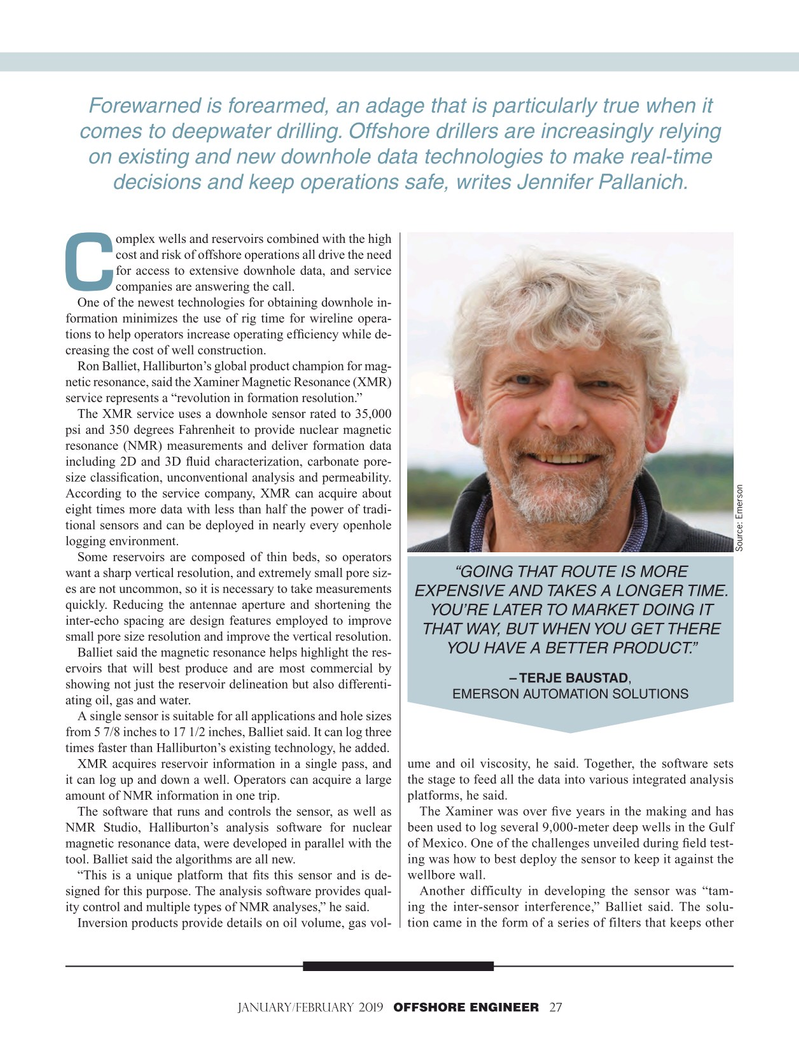
Page 27: of Offshore Engineer Magazine (Jan/Feb 2019)
FPSO/FNLG Outlook and Technologies
Read this page in Pdf, Flash or Html5 edition of Jan/Feb 2019 Offshore Engineer Magazine
Forewarned is forearmed, an adage that is particularly true when it comes to deepwater drilling. Offshore drillers are increasingly relying on existing and new downhole data technologies to make real-time decisions and keep operations safe, writes Jennifer Pallanich.
omplex wells and reservoirs combined with the high cost and risk of offshore operations all drive the need for access to extensive downhole data, and service
Ccompanies are answering the call.
One of the newest technologies for obtaining downhole in- formation minimizes the use of rig time for wireline opera- tions to help operators increase operating ef? ciency while de- creasing the cost of well construction.
Ron Balliet, Halliburton’s global product champion for mag- netic resonance, said the Xaminer Magnetic Resonance (XMR) service represents a “revolution in formation resolution.”
The XMR service uses a downhole sensor rated to 35,000 psi and 350 degrees Fahrenheit to provide nuclear magnetic resonance (NMR) measurements and deliver formation data including 2D and 3D ? uid characterization, carbonate pore- size classi? cation, unconventional analysis and permeability.
According to the service company, XMR can acquire about eight times more data with less than half the power of tradi- tional sensors and can be deployed in nearly every openhole logging environment.
Source: Emerson
Some reservoirs are composed of thin beds, so operators “GOING THAT ROUTE IS MORE want a sharp vertical resolution, and extremely small pore siz- es are not uncommon, so it is necessary to take measurements
EXPENSIVE AND TAKES A LONGER TIME. quickly. Reducing the antennae aperture and shortening the
YOU’RE LATER TO MARKET DOING IT inter-echo spacing are design features employed to improve
THAT WAY, BUT WHEN YOU GET THERE small pore size resolution and improve the vertical resolution.
YOU HAVE A BETTER PRODUCT.”
Balliet said the magnetic resonance helps highlight the res- ervoirs that will best produce and are most commercial by – TERJE BAUSTAD, showing not just the reservoir delineation but also differenti-
EMERSON AUTOMATION SOLUTIONS ating oil, gas and water.
A single sensor is suitable for all applications and hole sizes from 5 7/8 inches to 17 1/2 inches, Balliet said. It can log three times faster than Halliburton’s existing technology, he added.
XMR acquires reservoir information in a single pass, and ume and oil viscosity, he said. Together, the software sets it can log up and down a well. Operators can acquire a large the stage to feed all the data into various integrated analysis amount of NMR information in one trip. platforms, he said.
The software that runs and controls the sensor, as well as The Xaminer was over ? ve years in the making and has
NMR Studio, Halliburton’s analysis software for nuclear been used to log several 9,000-meter deep wells in the Gulf magnetic resonance data, were developed in parallel with the of Mexico. One of the challenges unveiled during ? eld test- tool. Balliet said the algorithms are all new. ing was how to best deploy the sensor to keep it against the “This is a unique platform that ? ts this sensor and is de- wellbore wall. signed for this purpose. The analysis software provides qual- Another difficulty in developing the sensor was “tam- ity control and multiple types of NMR analyses,” he said. ing the inter-sensor interference,” Balliet said. The solu-
Inversion products provide details on oil volume, gas vol- tion came in the form of a series of filters that keeps other
January/February 2019 OFFSHORE ENGINEER 27 18-31 OE 2019.indd 27 18-31 OE 2019.indd 27 1/21/2019 3:09:02 PM1/21/2019 3:09:02 PM

 26
26

 28
28